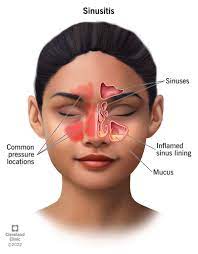
The four pairs of sinuses are as follows: –
The accepted functions of sinuses include, relative weight reduction of the front part of the skull (sinuses are hollow and filled with air), air-conditioning, and humidification of air that’s breathed in, giving added resonance to voice and lending mechanical rigidity.
1.Airflow into the sinuses
2.Mucous drainage out of the sinuses
Most patients with sinus infection will show some of the following symptoms: –
1.Stuffy nose
2.Obstructed nose
3.Cough
4.Headache
5.Recurring throat pain
6.Feeling of pain or pressure in face
7.Pain in ear and / or teeth
8.Weakened sense of smell
9.Trickling sensation / irritation in the throat
10.Recurring urge to clear the throat